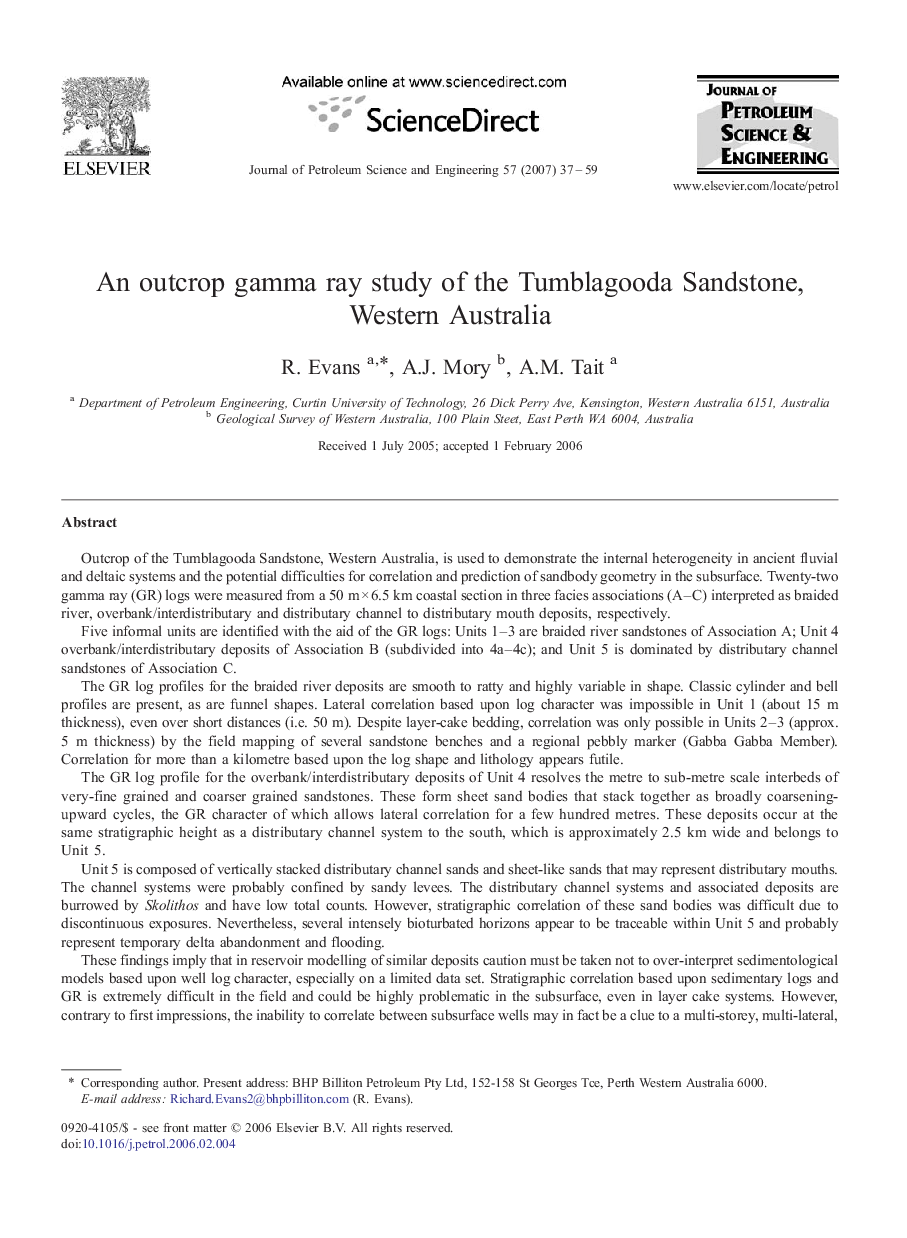| کد مقاله | کد نشریه | سال انتشار | مقاله انگلیسی | نسخه تمام متن |
|---|---|---|---|---|
| 1756521 | 1522892 | 2007 | 23 صفحه PDF | دانلود رایگان |

Outcrop of the Tumblagooda Sandstone, Western Australia, is used to demonstrate the internal heterogeneity in ancient fluvial and deltaic systems and the potential difficulties for correlation and prediction of sandbody geometry in the subsurface. Twenty-two gamma ray (GR) logs were measured from a 50 m × 6.5 km coastal section in three facies associations (A–C) interpreted as braided river, overbank/interdistributary and distributary channel to distributary mouth deposits, respectively.Five informal units are identified with the aid of the GR logs: Units 1–3 are braided river sandstones of Association A; Unit 4 overbank/interdistributary deposits of Association B (subdivided into 4a–4c); and Unit 5 is dominated by distributary channel sandstones of Association C.The GR log profiles for the braided river deposits are smooth to ratty and highly variable in shape. Classic cylinder and bell profiles are present, as are funnel shapes. Lateral correlation based upon log character was impossible in Unit 1 (about 15 m thickness), even over short distances (i.e. 50 m). Despite layer-cake bedding, correlation was only possible in Units 2–3 (approx. 5 m thickness) by the field mapping of several sandstone benches and a regional pebbly marker (Gabba Gabba Member). Correlation for more than a kilometre based upon the log shape and lithology appears futile.The GR log profile for the overbank/interdistributary deposits of Unit 4 resolves the metre to sub-metre scale interbeds of very-fine grained and coarser grained sandstones. These form sheet sand bodies that stack together as broadly coarsening-upward cycles, the GR character of which allows lateral correlation for a few hundred metres. These deposits occur at the same stratigraphic height as a distributary channel system to the south, which is approximately 2.5 km wide and belongs to Unit 5.Unit 5 is composed of vertically stacked distributary channel sands and sheet-like sands that may represent distributary mouths. The channel systems were probably confined by sandy levees. The distributary channel systems and associated deposits are burrowed by Skolithos and have low total counts. However, stratigraphic correlation of these sand bodies was difficult due to discontinuous exposures. Nevertheless, several intensely bioturbated horizons appear to be traceable within Unit 5 and probably represent temporary delta abandonment and flooding.These findings imply that in reservoir modelling of similar deposits caution must be taken not to over-interpret sedimentological models based upon well log character, especially on a limited data set. Stratigraphic correlation based upon sedimentary logs and GR is extremely difficult in the field and could be highly problematic in the subsurface, even in layer cake systems. However, contrary to first impressions, the inability to correlate between subsurface wells may in fact be a clue to a multi-storey, multi-lateral, braided river system. The internal heterogeneity described here is below the resolution of conventional well log data (approx. 30 cm), but resolvable on image log and core data. Deciphering the appropriate analogue data and semi-variograms to model and upscale the internal heterogeneity (of this outcrop and similar deposits) in three dimensions is a significant challenge.
Journal: Journal of Petroleum Science and Engineering - Volume 57, Issues 1–2, May 2007, Pages 37–59